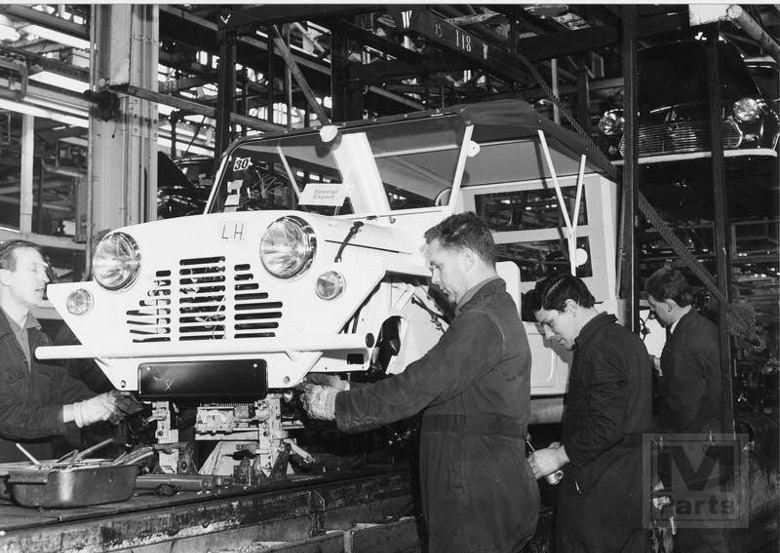

These Fun-Size, Jeep-Looking Vehicles Are Like Power Wheels For Adults
source link: https://www.slashgear.com/1234278/these-fun-size-jeep-looking-vehicles-are-like-power-wheels-for-adults/
Go to the source link to view the article. You can view the picture content, updated content and better typesetting reading experience. If the link is broken, please click the button below to view the snapshot at that time.
These Fun-Size, Jeep-Looking Vehicles Are Like Power Wheels For Adults
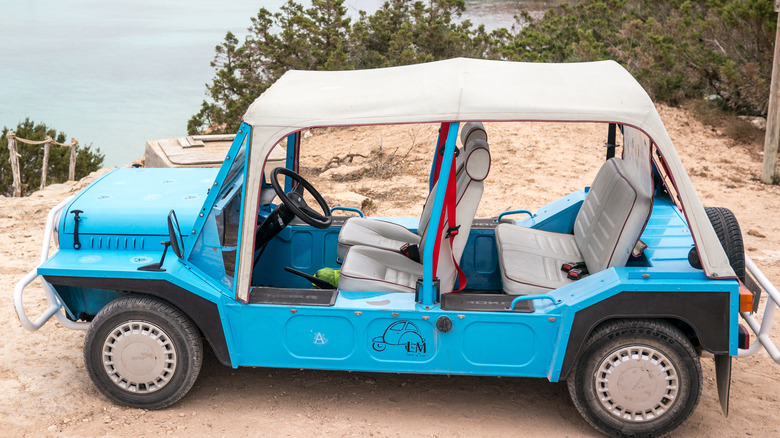
The Mini Moke may look like a toy, but it's a toy that adults could drive like kids on Power Wheels. Sir Alec Issigonis designed the original Mini Moke in the 1960s as a more rugged, off-road capable vehicle based on the original Mini. So despite its Jeep-like mug and boxy silhouette, it's not heretical to say the Moke (old British slang for "donkey") and the classic Mini share similar DNA.
Before it became a cultural hit among surfers and the stylish elite, the Mini Moke was supposed to enter service with the British army. It was light enough to be dropped in a parachute in combat zones or training camps, but the military had concerns with the Moke's low ground clearance and lethargic powerplants. Ultimately, the vehicle was deemed insufficient for military service.
Instead, the Moke became successful with the buying public as it entered commercial production in England by 1964. The British Motor Corporation (BMC) and its subsidiaries sold about 14,500 units to British buyers between 1964 and 1968, more than 26,000 units in Australia from 1966 to 1981, and 10,000 units to Portuguese enthusiasts from 1980 until the end of production in 1993.
Moke returns in America
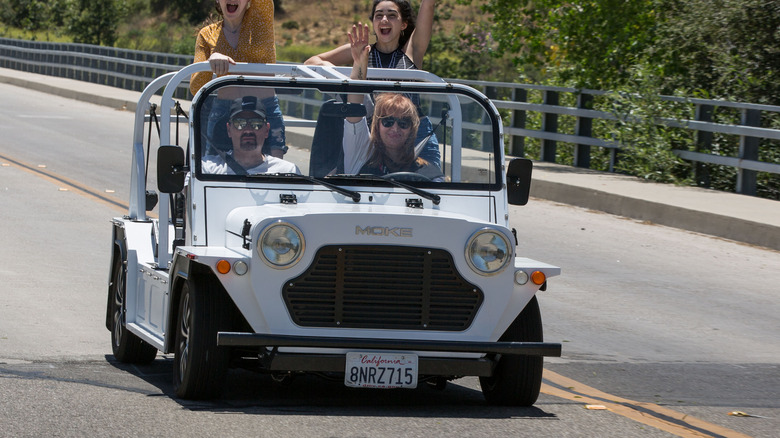
Moke America entered the fray in 2017 to revive the classic Moke, and it did more than drum up memories of forgotten yesteryears. The automaker has re-engineered the Moke: it's now bigger, wider, and heavier (about 2,300 pounds) than before. In addition, it has a taller and more prominent windshield to offer better visibility, and it comes standard with 14-inch steel wheels to add more ground clearance.
However, the most significant change is what's under the hood. Instead of a noisy gasoline engine, the new Moke is a battery-electric vehicle. However, it's not the Tesla kind of electric car. Instead, the new Moke is a low-speed vehicle (LSV) with a 25 mph top speed, numbers that won't impress your bar mates even after a few shots of swish.
It has a 60V single electric motor pumping out a maximum of 20 horsepower, 70 pound-feet of torque, and about 40 miles of range from its AGM battery pack. When the battery runs dry, it plugs into any 110-volt outlet to fully recharge in eight hours.
Big toy, big money
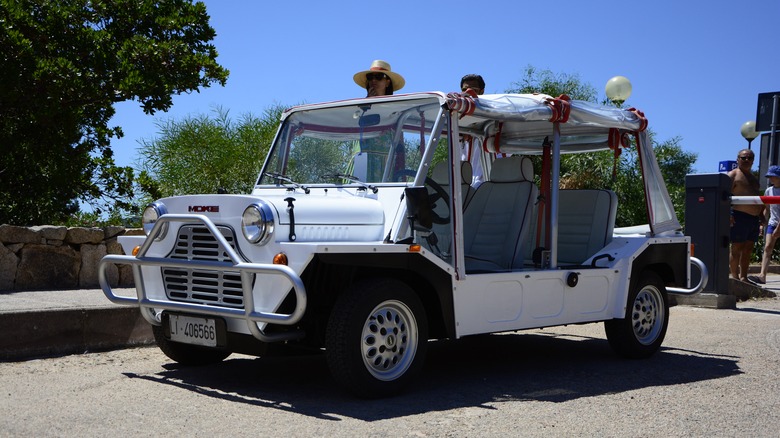
The new Moke is a four-seat Neighborhood Electric Vehicle (NEV) that's street-legal in all 35 mph driving zones. It has decent standard features like power steering, a front bumper, a backup camera, seatbelts, driving mirrors, weatherproof seat upholstery, a rollbar, and a stereo. Most of all, it's available in various paint choices (including a limited camouflage edition), and has a six-month bumper-to-bumper warranty.
Then again, there's a catch. The new Moke EV starts at around $22,975 before adding options like a glorious bimini top or a wood steering wheel, and the waiting time is about six months from production to delivery. You could get a brand new 2023 Nissan Sentra for about the same amount of dough, and we're talking about a proper five-seat compact car with more safety features and a fuel-sipping 2.0-liter engine that delivers 39 mpg on the highway.
However, the Sentra looks half as good as the Moke, so maybe renting is a better idea? Moke America's sister company WeMoke offers rental options to a growing list of locations, including Florida, Hawaii, Tennessee, Georgia, and New York. For around $475 per day, or $125 per hour, you can indulge in vintage glory all day while working on that tan.
11 Classic Pickup Trucks That Are Affordable Today
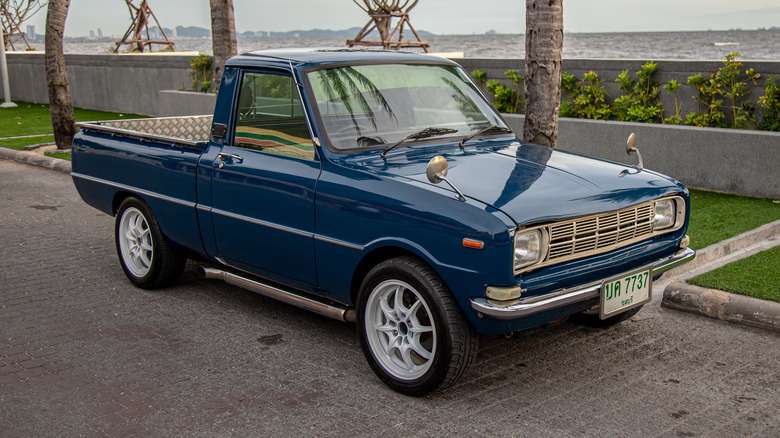
In many ways, the pickup is the backbone of America. Pickups do work for both personal and commercial purposes, serving to move our belongings to new homes and to haul plumbing and electrical equipment for repairs. There are countless jobs made easier by having a truck. Historically, trucks were built to do a job and not much else. However, with time, pickups have become much more comfortable, capable, and usable machines. Trucks used for personal transportation used to be rare and the trucks available were much more austere. But times change and so do the machines we use and that has made for radical transformations in the modern pickup truck.
Since trucks have such a high level of utility, they tend to keep their value longer than comparable cars of the same age. The higher values of some models tend to extend even when the truck has aged to the point of being called a classic or antique. Today, most Ford or Chevy full-size trucks built before 1990 are seeing their values go up extraordinarily high. Old square-body Chevy trucks in good condition are seeing values of $15,000 to 20,000 today, and Fords are equally valuable. Other models are more reasonable. Considering an affordable classic to be around the $10,000 or less price range that can be driven and won't be an embarrassing eyesore in your driveway, these are 11 classic pickup trucks that remain affordable today.
Ford Courier
To capitalize on the growing popularity of small trucks in the US, Ford opted to associate with Mazda to import its small B-series truck and give it the name Courier. It was a typically small Japanese truck with not much more than a bed, a four-cylinder engine, and a steering wheel. Pretty much everything else was optional, but no options were offered. The little trucks were made to do light work and do it efficiently. They caught on well with Americans and the success of these trucks is what encouraged Ford to develop its own and replace it with the Ranger a decade later (via The Truth About Cars).
These little trucks were once considered practically disposable. Owners used them and beat them up until they would not do any more work and they went on to be crushed. Only with the mini truck scene of the '80s and '90s did they become more relevant, however, the Courier was never one of the choice models for doing lowriders and such. They are hard to find today but can be had for a reasonable price once found. Recent listings on Fordcourierforsale.com reveal a few Couriers in excellent condition, running, and with nice paints for $5-6,000, while several in decent usable condition sell for less than $3,000. For someone looking for a clean old truck, these Couriers are a great option.
[Featured image by Magnus Manske via Wikimedia Commons | Cropped and scaled |CC BY-SA 2.5]
Dodge Rampage
While Ford and GM worked to release scaled-down versions of their full-size trucks to market, Chrysler took a different path. The brand came late to the show importing from a Japanese partner and, shortly after bringing over something from Mitsubishi, it made a domestic truck to be sold on the same lots, the Rampage.
Built upon the Dodge Omni platform, the first front-wheel-drive economy car built in the U.S., the Rampage and Plymouth-badged Arrow were both marketed as a "sport truck." Unlike its American counterparts, it is unibody construction with a transverse-mounted engine driving the front wheel, although the rear suspension used leaf springs and was built stronger to handle loads. It is an economical small truck with unique styling, but it was not very popular and Chrysler failed to sell a substantial number of units, with peak sales of 17,636 in 1982 (via Auto Evolution).
Despite being a unique, quirky, and rare little truck, its value has not risen significantly over the years. Rampageforsale.com lists a few like-new condition models for $4-6,000, with mint condition and low-mileage model prices at $10,000. Compared to full-size Dodge trucks of the period, that is a steal. While these may be good deals, a dedicated buyer who dug a little deeper could come across a Shelby version with the same turbo 2.2-liter engine from the Omni GLH and have a fun little truck.
[Featured image by Greg Gjerdingen via Wikimedia Commons| Cropped and scaled | CC BY-SA 2.0]
International Harvester Pickup
The return of the Scout name in a new electric vehicle from VW is coming, resurrecting the name from an old model from International Harvester, or IH. That vehicle was originally based on a pickup that the company produced for decades before leaving the consumer market altogether in 1975. While the old Scouts are now some of the most valuable old trucks on the market, the pickup versions have remained more affordable.
In the early 20th century, says Motor Biscuit, IH was busy building farm equipment and tractors and soon saw the market potential for putting together a light-duty truck for sale. It was at least moderately successful as the IH truck was sold from 1907 through 1975. While its sales were enough to keep it going for many decades, it always trailed the other manufacturers, coming in fifth place in the American market. These old trucks are robust workhorses with distinctive, yet basic styling. The trucks spawned the Travelall wagon and the off-road Scout. Those variants are highly desirable today, though the truck is often overlooked in the classic market.
Although IH sold fewer trucks than the competition, many thousands hit the road over the years. IH trucks can still be found for sale, although it may take a bit of searching to find the right one. A look through ads on Auto Trader shows that decent original condition trucks can be found for around $10,000 with lower asking prices for those that need work.
Chevrolet S10
If anything was learned by the Big Three Detroit automakers in the '70s, it was that Americans loved small trucks. With their shared success importing Japanese trucks to sell under American brands, managers found a reason to make similar trucks here at home. To that end, Chevrolet released the S10 in 1982 to replace its Japanese import. The S10 was an instant success and continued to be a good seller until production ended in 2004.
The debut model offered consumers a choice of a 1.9-liter four-cylinder or 2.8-liter V6, and added a diesel variant in 1984, although few sold. The little trucks were attractively styled with some features resembling their full-size stablemates and others that were distinct for the model. As the S10 evolved, options such as four-wheel-drive and extended cabs were offered and the truck received more refined and upgraded interiors. For a time, it would have been impossible to drive through any American city without seeing the S10 on the roads.
Because of the high volume of trucks produced and the length of time they remained in production, older models are readily available. The values have not risen substantially and S10 trucks can be found in various conditions for reasonable amounts. The S10 is a popular truck for lowrider customs as well as a beater truck meant for work and abuse. A search on Auto Tempest will provide some affordable options, although finding something close to home may be impossible.
Jeep Gladiator and J-series
Kaiser-owned Jeep introduced an all-new truck in 1963 called the Gladiator, replacing a truck that was still based on designs from WWII. This new truck would bring the brand up to date in styling and performance as well as establish the look of its vehicles for the next few decades. While the new Gladiator would rival other American trucks' off-road capability, the lack of a V8 engine meant they were underpowered. In 1963, notes Car and Driver, the only engine was a 230-cubic-inch inline-six with 140 horsepower, which was joined by a low-compression economy version the next year. A V8 would not show up until 1965. AMC bought Jeep in 1969 and introduced its legendary inline-six and robust V8 engines to the lineup.
The Gladiator name was phased out in favor of J-series, although it has since been revived for a modern truck based on the current Wrangler. It also spawned the Wagoneer and Cherokee Chief wagons, which are among the highest-valued classic trucks today. Despite the substantial increase in value of the wagons, the trucks can still be found for less money. JeepTruck.com offers free listings for Jeeps and J-series trucks in perfectly usable condition can be found under $10,000 while like-new and restored condition trucks edge closer to double that amount.
Dodge Ram 50
Showing up late to the mini truck party was Chrysler, waiting until 1979 to import a truck from Japan. Chrysler had a relationship with Mitsubishi dating back to the imported Dodge Colt in 1971, so a rebadged truck made sense. For the first two years, it was called D50 before being named the Ram 50 and Power Ram 50 for four-wheel-drive models. While Chevrolet and Ford moved on to domestically-built trucks around 1980, Chrysler continued to import the Ram 50 until 1995, many years after the Dakota debuted, per MightyRam50.
Dodge's Ram 50 had a good run and sold well throughout its time on dealer lots and outlasted all the other Japanese-built trucks. The Ram 50 and its Mitsubishi twin were popular in the minitruck and lowrider scene of the '90s and may be hard to find these days. Modified trucks are still rather expensive, but the other more ordinary models can be found for $5,000 to $8,000 in great shape, judging from the recent history from Classic.com.
[Featured image by Dave_7 via Wikimedia Commons | Cropped and scaled |CC BY 2.0]
Volkswagen Rabbit Pickup
While the West German Volkswagen company spent decades exporting curvy economy cars to the US, most people might be surprised to hear that its Rabbit Pickup is a purely American creation. The diminutive pickup was born in VW's Westmoreland, Pennsylvania, factory as a result of having unused production capacity and a few clever designers on hand. Realizing how easy it would be to take a rabbit, chop off the rear hatch, and then bend a bit of sheet metal to form a bed, VW of America made this happen and created one of the most popular small trucks around the world (via Road and Track).
The little truck was offered with a choice of a 1.7-liter gas engine or a 1.6-liter diesel. Both of them were slow in a way that makes turtles look like Olympic sprinters. But speed and power are not why someone buys a VW pickup. These little trucks are for hauling a couple of chairs, your uncle's lawnmower, or cases of beer for a summer cookout. Lots of these trucks spent time on farms as beaters that never left the property and most of those rusted out long ago. Trucks in excellent condition can sell for fairly high amounts. VW fans tend to be on the more fanatical side and may shell out for certain models in mint condition. However, looking through VwTruckForSale.com can result in finding several good used daily drivers for around $5,000.
Subaru BRAT
For a period of about 10 years ending in 1987, Subaru built the most quirky and adorable pickup ever made. Instead of designing and engineering a new platform to create a pickup for sale in export markets, particularly the U.S., Subaru took an existing wagon called Leone and chopped off the rear to make a truck. If this part of the model development was not clever enough, Subaru bolted a couple of jump seats in the bed of the BRAT to avoid a 25% tariff on imported light trucks, something known as "The Chicken Tax." With the rear-facing seats installed, the BRAT qualified for the normal passenger car tariff of just 2.5% (via Motor Trend).
Subaru ended production in 1987 a couple of years after the loophole allowing the little truck to avoid the tariff was closed. BRAT, by the way, is an acronym for the vehicle's full name, Bi-Drive Recreational All-terrain Transporter. Its usefulness is quite low, even with the rear seats removed. Its bed is small and it's not able to carry heavy loads, however, the four-wheel-drive system and light weight make them great for off-road use and having a bit of fun. With an estimated 100,000 sold in North America, BRATs can be difficult to find. For anyone who wants a fun classic truck, BRATs can be a perfect choice. Only the absolute mint condition trucks sell for high dollar amounts, and BratForSale.com reveals many nice examples for around $5,000.
Dodge Dakota
When Chrysler introduced the Dodge Dakota in the late '80s, it created an all-new truck category and the Dakota remained its sole member for nearly two decades. While American and Asian companies had been building small trucks for some time, it was Dodge that presented us with a mid-size option. 1987 was the first year for the Dakota and introduced the concept of a downsized pickup and remained the sole model in that category until the Chevrolet Colorado showed up in 2004. And the Dakota, which Hagerty called a "segment buster," has long been a desirable truck for its ability to haul competently while being less unwieldy and easier to manage than a larger truck.
Introduced in 1987, it bumps up close to the arbitrarily chosen model year of 1990 to classify it as a classic pickup. Yet plenty of these trucks remain on the road, as Dodge sold millions of them. Dakotas managed to avoid being hacked up for the mini truck scene as they were too large, which means clean, stock-condition trucks are still able to be found. Auto Trader lists a few at the time of writing from $5,000 for decent and drivable examples to $10,000 for an excellent truck that is exceptionally clean and straight for its age. These may be a bit undervalued at the moment, however, the unique convertible Dakota Sport and Shelby versions are rare models that command a premium, setting you back around $20,000 for one in above-average condition.
Mazda B-series
The history of the Mazda truck in North America starts in 1972 when the Hiroshima-based company began exporting its plucky little B-series trucks over the Pacific as the Mazda B1200 and Ford Courier. This dual-model export system continued until Ford developed the Ranger, although Mazda continued selling its own trucks until 1994 when Mazda began selling rebadged Rangers as B-series trucks. Mazda continued selling Japanese-made trucks everywhere except North America. Mazda trucks were, for the most part, highly similar to other Japanese trucks on the market with one exception, the Rotary Pickup, powered by the rotary engine from the RX-4. As Wankel engines are light on torque, notoriously thirsty, and maintenance-heavy, the REPU did not last long (via Car Throttle).
Mazda trucks, like other Japanese trucks, are basic durable workhorses. They are endlessly reliable and surprisingly tough. Interiors from the early ones are spartan, while the later models of the '80s and '90s are much more refined but still basic. These B-series trucks are a favorite of the mini truck scene with countless customs being made from them. They are still affordable and it seems that plenty are still available for purchase. Listings from Second Life Truck show an abundance of pre-Ranger trucks that can be had for a couple of thousand dollars, although they might need some work. Bring a Trailer does not have many recent listings, but one displays a truck that sold for $9,500 that looks like it just rolled out of the dealer's lot.
Datsun 620
The little Datsun 620 pickup was one of the first Japanese vehicles exported to the U.S. and is at least partially responsible for the popularity of such vehicles. The first ones were closer in size to a golf cart than an American truck, but their popularity rose first on the West Coast among surfers and slowly spread to other parts of the country. Early Datsun trucks were powered by 1.0-liter engines that grew every few years up to 1.6-liter before being rebranded as Nissans in the '80s (via Motor Trend). These trucks are well-known for their durability and economy but are also known for being bare-bones and as basic as it gets.
Datsun and Nissan trucks are desired models for the custom mini truck scene. Their rock-solid reliability and durable chassis also make them popular for those who want an older truck for daily use. Despite the desirability of these little trucks for custom or utility, they remain affordable for collectors. Those wanting to find a truck to refurbish or restore should have no trouble finding one in reasonably good condition needing a moderate amount of work, however, rust can be a problem, especially in the beds. The few recent sales shown on Bring a Trailer for the 620 models from the seventies are still not too high, with excellent examples going for $5- to 7,000. Older listings show near-perfect condition trucks selling for less than $7,000, but those prices will likely be up sharply for future auctions.
Recommend
About Joyk
Aggregate valuable and interesting links.
Joyk means Joy of geeK
